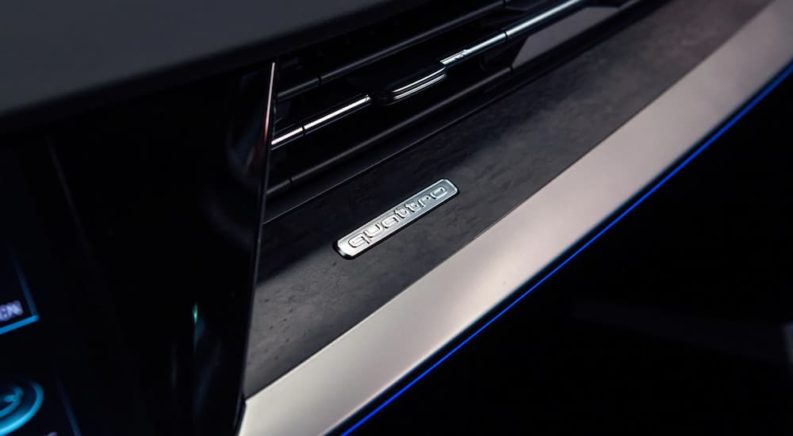For reasons known only to the ether, I will never forget my first exposure to the “quattro” name––it was associated with the breathtaking “Le Mans quattro” concept car, which heralded the coming of the Audi R8 mid-engine supercar. I wasn’t remotely tuned in to racing at the time (the concept’s name honored Audi’s incredible Le Mans wins from 2000 to 2002), but the stunning look of the car that was later featured in Need For Speed: Carbon and (in production form) Iron Man imprinted itself firmly in the deepest wrinkles of my brain.
What I didn’t know then was that “quattro”––with a lowercase “q”––had been an Audi signature for over 20 years (40 years, now) or that the name is associated with both a model and a drivetrain in the most strangely natural fashion. It represents a model and a technological advancement––”Vorsprung durch Technik” in action––that both hold an important place in automotive history. quattro is also a critical focal point in the journey to wrap one’s head around the myriad ideas involved in all-wheel drive system design. It’s a concept that changed the automotive world, four wheels at a time.
5, 4, 3, 2, 1…Begin!
An uncommon 5-cylinder turbocharged engine. A first-of-its-kind 4-wheel-drive system. 3 consecutive record-setting Pikes Peak hill climbs. 2 World Rally Championship titles. A 1-of-a-kind 1980s sports coupe. The Quattro––capital Q––took full advantage of new rules that allowed rally racers to use AWD and wound up inspiring a generation of racing fans.
You’ve got to hand it to the Germans. The one time––the ONE TIME––they gave a real name to a luxury brand car, the name was another language’s word for a freakin’ number. At least the name makes sense, referring to the full-time AWD system that the car was built around. Which it really was––the Quattro may be one of the industry’s best examples of a “parts bin special,” loaded with pre-existing Audi bodywork, Volkswagen parts, and Porsche ducting, all cobbled together to put something competitive on top of the bespoke drivetrain.
And boy, did that concept fly. The Ur-Quattro (basically Audi-speak for “the OG 4”), as it’s come to be known, was the beneficiary of locking center and rear differentials, activated individually with aerospace-inspired plungers in the center dash. Inspired by the VW Iltis military vehicle’s confidence on snowy terrain, one major departure was to do away with a transfer case and instead put the center diff’s forward output shaft down the center of the main driveshaft!
This absurd-sounding concept allowed AWD to work for a “vertically challenged” design, saving weight and space. With it, the Quattro demonstrated that sheer power was a secondary concern once road conditions went to hell––to prove the point, Audi famously drove one up a ski jump at an 85% grade in the snow for a commercial!
Combined with a turbocharged 5-cylinder engine––compromising between an I-4’s compact size and an I-6’s displacement and power, adding NVH to the ride and a gorgeous snarl to the soundtrack––this AWD system propelled the Quattro to dominant victories in the WRC and at Pikes Peak, where it set and broke its own records by huge margins three years in a row.
The Quattro was competitively priced against BMW and Jaguar and enjoyed fantastic PR until accidents––which plagued all of Group B rally racing––led Audi to voluntarily withdraw from rally racing in 1986. Despite this, fewer than 12,000 units were sold––just 664 of which were in the US, lending the Quattro the air of a halo car despite it never really being positioned as one. Its success enshrined it, though, and now its name appears on millions of AWD Audis around the world.
quattro for All, and All for quattro
The Ur-Quattro was an incredible rally car, to be sure, but the front-mounted engine created an uneven weight distribution that did a disservice to the car’s handling. Ever mindful of achieving “Vorsprung durch Technik” (progress through technology)––not only an Audi slogan but a post-war German one––the quattro system has evolved through six generations and endless adaptations, with every model receiving a uniquely balanced design and no intentional correlation between major model changes and major quattro redesigns.
The first of these came in 1988 with a switch from the manually actuated center diff to a Torsen (TORque SENsing) Type 1 unit. The significance of this cannot be understated––the Torsen is a fully automated, self-contained mechanical unit, with no electronic controls or even regular maintenance required, capable of mild torque vectoring to the front or rear axles to prevent slip. This proactive torque vectoring is completely seamless, even during hard maneuvering, shifting from a 50:50 split to as much as 80:20 to preserve traction.
The system isn’t perfect––as a mechanical limited-slip diff, the Torsen system can only support a limited torque differential from end to end. That is to say, if the system supports a 50 lb-ft torque differential and one end has no traction, the other end is only getting 50 lb-ft of torque regardless of the engine output. It also has an at-the-limit performance detriment: the natural 50:50 torque split is influenced by the weight distribution of the vehicle, causing the nose-heavy Ur-Quattro to understeer more than expected when driving at 10/10ths.
After a couple iterations which saw the rear diff upgraded to another Torsen and then to an open electronic differential lock (which the front axle had as well), in 2006, quattro’s Torsen Type 1 was replaced with a Type 3 on the RS4, representing a major leap forward. This unit had a rear torque bias ratio of 40:60, using a planetary gear set to add an RWD lean to its behavior, and (factoring in the capabilities of the Electronic Stability Program) could send 100% of torque to either axle!
The follow-up to the Type 3 wasn’t long coming––Audi’s own “Crown Gear” unit replaced it in 2010! This complex but compact system has the same natural 40:60 split but can run as much as 70:30 or 15:85, depending on conditions. With internal clutch packs naturally engaged by operating conditions, the Crown Gear is a fully locking differential (unlike limited slip Torsens, which begin to slip above a certain torque differential limit), improving the range of operating conditions for quattro. It’s also nearly 30% lighter than a Torsen Type 3 and integrates more readily with electronic control systems to enable full four-wheel torque vectoring.
A “Sport Differential” became an option for the rear axle of quattro systems around 2006 as well, which added the ability to essentially speed up the outside wheel during a turn––thereby countering understeer and enhancing turn-in. This Magna product remains an add-on option for many Audis today, especially in the S and RS categories, where lap times are king. Imagine a scenario where nearly all of the torque is going to one wheel––it could turn on a dime if it had to!
The Crown Gear with a Sport Differential represents the current pinnacle of longitudinal quattro design, but Audi’s lineup is far too diverse to limit quattro there.
quattro Side to Side and Back to Front
Not every Audi has the dimensions to handle a longitudinally oriented engine, which is a bigger deal than it sounds. Sending power to the rear wheels from a transverse engine is no simple matter, which means quattro needs a different look in such models.
Here the Torsen differential is replaced with a Haldex Traction limited-slip coupler––not a differential, but a device using a clutch to engage the rear axle under adverse conditions. It’s not quite as performance-minded as the Torsen––most of the time, these models act as FWD, and the electronically-controlled Haldex is inherently slower to react: it engages in order to stop slip, while the Torsen adjusts to prevent slip. That being said, under most real-world driving conditions, FWD is a preferable option for efficiency, and under most AWD conditions, the split-second lag of a Haldex behind a Torsen is imperceptible.
The R8 supercar enjoys a slightly different system thanks to its longitudinal rear mid-engine layout. In this car, the hydraulic clutch pack is integrated into the linkage between the S Tronic transmission and the prop shaft and has no standard torque distribution. Instead, it adjusts to be “optimal for current conditions” and can swing all the way from 0:100 to 100:0. That’s a fitting extreme for Audi’s most extreme car!
Now, as the e-Tron gains steam and the future looks increasingly electric, mechanical quattro systems might be as close to their demise as the V8 engine. With independently-driven axles, Audi e-Tron models are AWD by default and have no need for clever mechanical systems. Instead, they use sensor inputs to make millisecond-quick calculations and decisions about whether the front motor should be energized at all and, if so, how strongly. Torque vectoring through braking remains a staple, of course, and to the driver, the adjustments are seamless––just as a quattro ought to be.
quattro 4-ever
I didn’t really think about AWD systems much when I was growing up. Some vehicles had it, many didn’t, and those which had it were ideal for slippery, unstable conditions––simple, easy, got it, good. It’s been mind-blowing to discover just how complex the world of AWD really is and how many unique systems exist, all taking different approaches to achieve the same end: the maximum possible grip and control when it matters most.
Ur-Quattro was the first performance car to bring full-time AWD to the market, and despite relatively weak sales, its success on the race track has defined a brand for generations. Over 8 million models with quattro have been sold around the world in the last 40 years, proving the appeal of a system characterized by its focus on seamless optimized performance. As this system transitions into the realm of EVs, it won’t be any surprise if it takes only half as long to make 8 million more.




